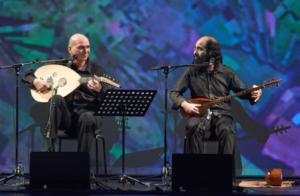Beneath the regal arched ceilings of the Christ Church Cathedral, a small audience gathered on Friday night to witness a select performance of ancient Greek music ranging from the 14th to 18th Century. The seven-member band, featuring members of En Chordais and Constantinople, formed an intimate ensemble, performing acoustically within an enclosed chapel within the cathedral.

The instruments that were used have likely never been heard by many people attending: there was the setar, kanun, ney, and unique variations of violin and percussion instruments. One of the most engaging things about any live performance is listening to the rich landscape of sound enveloping the audience and watching those sounds being produced in real time, right before your eyes. With more familiar music, individual instruments are easily distinguished and picked out of the soundscape, but many of these instruments produced sounds I was wholly unfamiliar with, and I spent much of the performance captivated by the puzzle of disentangling the complex melodies into their component parts.
For those who have never heard Greek music, the sound is similar to that found in Arabic, Persian, and Indian music, utilizing what is known as nodal music rather than the tonal music we’re more familiar with. Tonal music, such as the guitar or the piano, has a very limited number of discrete intervals between notes, while nodal music has a far wider number of intervals for a more complex sound. (An example of a tonal instrument played nodally is the slide guitar, where the distinct frets are bypassed by sliding between notes to achieve nearly infinite intermediary tones.)
I think the greatest difference between this sort of Eastern music when compared to classical European music such as Bach or Beethoven is that classical music feels highly structured and regimented, whereas Greek music as I witnessed here feels more organic and free-flowing, accentuated by a vocal performance that appears to focus on the liquid flow of sound, rather than the words themselves. While both styles are composed, the distinct styles represent the differences between Western and Eastern cultures.
The opportunity to listen to music that is vast centuries old is a rare one indeed, and I’m grateful that in our age of modernity, such archaic music is being kept alive for new generations to experience music as it used to be, and perhaps to carry on the tradition by giving it new life within an old style.
